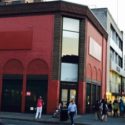

One of the definitive bitter sweets of Manhattan living—for any reputable length of time—is the bearing witness to the Darwinian evolution of neighborhoods. I wrote about the Meatpacking District recently with some sort of claimed nostalgia, but… when was I ever in the Meatpacking District when it was a meatpacking district? I never patroned now sinking ship Hogs ‘N Heifers (closing Aug 23rd) after a long day at the slaughterhouse. But… I absolutely remember 8th Street (and by natural extension eastward, St. Mark’s Place), what it looked like when my first NYU dorm was only two blocks north on East 10th and Fifth Ave.

Truth is, it’s changed much more than its westerly concrete compatriot, the MD. Or at least, changed MORE over a shorter duration. Eighth Street is formerly the unofficial Manhattan “Shoe District”. Once home to over twenty different sneaker and shoe shops—from the high end Italian in-house leather variety to the warehouse of boxes piled floor-to-ceiling of old Chucks (I’m psyched about the brand reboot this week) and Run DMC-approved Adidas and checker cab Vans. These, of course, along with Eva’s (a health-forward store long before the days of Juice Generation or even the old The Pump. Also, the visual arts school and Cassiopeia Body Piercings (now, only its sister store Andromeda—featured in an iconic episode of AbFab—remains on St. Mark’s).

Also, the historic Electric Lady Studios (everyone from Jimmy Hendrix to the Beatles to Lana Del Rey have recorded there) now resides completely surrounded by this monstrosity (pictured above). At least ELS didn’t lose their lease. There’s been a lot of THAT going around: the out-pricing, upcharging, landlord-gouging, mom-and-pop-squashing of neighborhood shops and eateries. Just this week, famed punk clothing headquarters Trash and Vaudeville, announced they are moving over to East 7th. And not for the reasons you might think—yes, the rent is ever increasing; however, one of the owners maintains that his audience has moved. St. Mark’s has now become a bit, well, touristy, just steps away from the Orpheum and Hamilton-worshipping The Public Theater, and all.

I devoted a passage in my book to this topic:
The neighborhood was Alphabet City: where the avenues ran out of numbers so they resigned themselves to letters, off the grid, the kind of neutral ground appropriate for signing a treaty or negotiating terms of a truce. Emily and Lillian weren’t allowed here in their teens. Don’t go past A after dark, their mother had warned. Public housing projects still lined Avenue D, but the neighborhood had become considerably more funky than dicey.
Emily suggested Yaffa Cafe, a familiar haunt. And if it was haunted, the spirits here were most likely a mixed bag of grittier-than-Billyburg hipsters, eccentric Eastern European ladies-who-lunch cheaply, the nearly extinct club kid in search of 5 AM falafel, and the odd New York celebrity. Like Honey Bijoux—sitting at a corner table—a transsexual superhero, pulled tighter than the Cat Lady by a host of South American surgeons, in a two thousand dollar wrap dress she most definitely did not pay for.
Yaffa was located just off the avenue, a few steps down from the sidewalk. Bold stripes were painted on the outside like some urban beach cabana. The theme was no theme. Interior walls alternated between exposed brick and an assortment of wallpaper—swirling patterns interrupted by cracked mirrors reset in vintage frames, still life paintings of fruit, and kitschy advertisements from the 1940s. Heavy curtains were draped across the doorways leading to the kitchen and the loo, as it was marked. A collection of Buddha heads were scattered throughout—several lit up. Lamps on side tables boasted tawdry beaded shades.
Emily sat at a table alone. It was wobbly though she didn’t dare ask the waiter to adjust it—it wasn’t that kind of place. She was waiting for Royce, an all-too-serious, outwardly stubborn, self-conscious scientist-guy. The kind of guy who’s been going to the same barber for seven years. He was more likely to crash a lecture than show for a doctor’s appointment and would sooner take a bullet than dance in public.
Royce sat hard—he’d always been a plopper. “Hi.” He didn’t kiss her, not even on the cheek. She made a habit of not noticing things like that lately. But deep down, she knew this pairing had reached the helium-burning stage of a red supergiant. A grim inevitability.
“How was work?” Emily asked, missing the days of unprompted conversation spewing effortlessly, the volleying back and forth, completely engaged and genuinely interested. The waiter dropped a menu in front of him and strolled away in his Sharpie-embellished Chucks to chat with a regular too old for pigtails. Emily watched Royce take in the café: the perennial Christmas lights, the tinsel, the hanging plastic grapes, the overdone everything.
“This was a good spot to meet, but I’m in the mood for… something different.” He hadn’t even glanced at the menu. “You mind if we get outta here?” She didn’t, really. She was at that point in the relationship where she’d given up on everything except pleasing him, just to delay what was unavoidable.
They left and another couple sat at the same table five minutes later. The waiter didn’t even realize they were different customers.
Emily and Royce walked west against traffic on St. Mark’s Place, the strip of corrupt punk activity in the late seventies, alternative galleries where the likes of Keith Haring and Kenny Scharf gave bloody birth to a new wave of pop art, and the now defunct, infamous Gay bathhouse, shut down by the Board of Health during the AIDS crisis. Still colorful though commercially watered down, NYU students now pierced a belly button instead of a vein.

Sorry, comments are closed for this post.